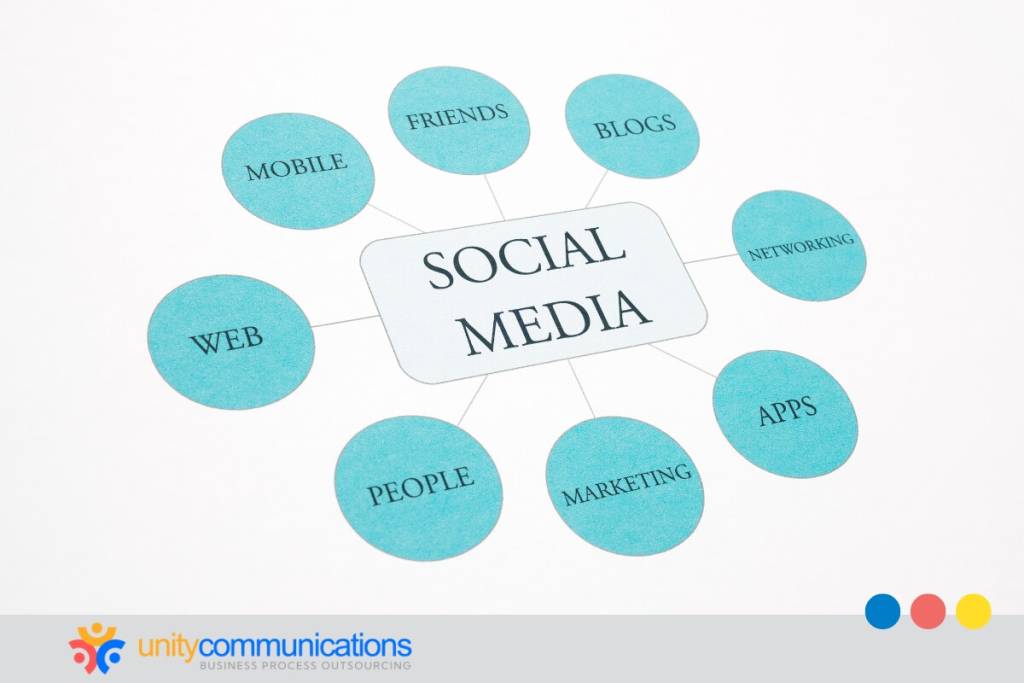Table of Contents
If you’re running a small business without a social media marketing strategy, you’re missing out on one of the most effective ways to grow your brand. Platforms such as Facebook, Instagram, TikTok, and LinkedIn connect your brand with your audience, boost brand visibility, and drive sales. But without a clear plan, social media can drain your time without delivering results.
Whether you’re handling it yourself or exploring social media marketing services, a focused strategy is key. This article walks you through the steps to build a strong, results-driven social media strategy for your small business. Read below to learn more.
Why a social media strategy matters for small businesses

Having a social media presence isn’t just about being online—it’s about being strategically online. A well-defined social media marketing strategy ensures your time, energy, and budget bring measurable results. This kind of clarity is essential for small businesses where every resource counts.
Without a strategy, it’s easy to fall into a scattergun approach, posting without direction, consistency, or goals. This wastes time and makes it hard to evaluate what’s working and what’s not. With a plan, you can create intentional, trackable, and scalable content.
A strong social media presence also provides the following benefits:
- It helps your brand stand out.
- Social media gives your business a voice and personality, helping you connect with your audience more authentically.
- Social media helps you build trust. When people see consistent, valuable, and engaging content from your business, they’re more likely to remember and believe your brand.
According to a report by Sprout Social, 90% of consumers buy from brands they follow on social media, and 78% want brands to use such platforms to help people connect. These data emphasize the value of a solid social media presence.
However, social media management requires extensive monitoring and engagement to convert passive followers into loyal customers. For small businesses, hiring a business process outsourcing (BPO) company can address this problem.
Third-party experts can:
- Customize your content strategy.
- Perform routine tasks such as posting consistently and creating a content calendar.
- Engage your community.
- Collaborate with the rest of the marketing team to align tactics and expectations.
All these give you more time and resources to focus on other high-value activities, such as product development.
A robust social media marketing strategy helps grow your audience, deepen customer relationships, and drive real business growth.
But how do you and a BPO provider create one?
9 proven steps to build a successful social media strategy
Social media platforms level the playing field. Despite limited resources and budget, they allow you to compete with more prominent brands. Most free platforms have substantial user bases and feature tools to run organic and paid campaigns.
To hit your marketing goals and stay competitive, you need an effective, scalable social media marketing strategy. It can help you stay consistent, reach the right people, and maximize your time and resources.
Here’s a step-by-step process for crafting an effective social media marketing strategy:
1. Set SMART goals to provide direction
Start with the end in mind. What do you want to achieve with your social media efforts? Is it to build brand awareness or increase website traffic? Perhaps you want to generate more leads or boost sales.
Whatever the intention, clarity is crucial to optimizing resources, tracking the right metrics, and achieving desired outcomes. Most BPO companies recommend setting SMART goals to develop focused social media tactics. SMART stands for: specific, measurable, achievable, relevant, and time-bound.
To illustrate how this works, suppose you are a newly opened New York real estate company competing against established agencies targeting the same neighborhoods and keywords. A vague goal might sound like this: “We want to improve our online visibility.” Although well-intentioned, it doesn’t specify what “visibility” means or how to achieve it.
A SMART goal is to “increase organic traffic to our website by 30% in the next 90 days by publishing two hyperlocal blog posts weekly focused on NYC neighborhoods and optimizing each listing page for local SEO keywords.”
This framework can also be platform-specific. For example, you might want to grow Instagram followers by 20% or generate 50 leads on LinkedIn through content offers. A platform-specific goal can align your strategies with audience behavior and allow you to achieve more impactful results on each channel.
2. Know your target audience
You can’t market to everyone, and you shouldn’t. Understanding your core audience helps you create engaging and actionable content. But where do you begin?
Think about demographics, behaviors, interests, and pain points. Who are they? What are they looking for? How can you help?
You can take audience identification further by analyzing your current customers and social media insights:
- Look at who’s already engaging with your brand: their ages, the time they’re most active, their location, and the content types they consume.
- Use tools such as Facebook Audience Insights or Instagram Analytics to uncover trends and preferences.
From the data, you can develop or update your customer personas, which are semi-fictional characters of your intended audience. They guide your messaging, resource allocation, social media channels, and strategies.
For example, your data might reveal that most of your leads are first-time homebuyers in their 30s who prefer Instagram over Facebook. You can then create a persona like “Budget-Conscious Millennial Buyer” to guide your content and platform choices.
The better you understand your audience, the easier it becomes to build meaningful connections with them online.
3. Choose the right social media platforms
It’s tempting for small businesses to be on every platform, but doing so can quickly dilute their resources and overload the internal team. Tracking is challenging because each site has different metrics, algorithms, and audience behaviors. Most importantly, a large following doesn’t always translate to meaningful engagement or high conversions.
Focus your efforts where they matter most and optimize your content for each platform to get the best results. Each platform has unique strengths and user profiles. As of April 2024, Facebook is the most popular social network worldwide, with over 3 billion monthly active users. Instagram has shown significant growth, with a 25.3% year-over-year increase in audience size as of January 2024, indicating its rising popularity among users.
Understanding these trends and user demographics is crucial for creating content and deciding where to invest your time and resources. By identifying the platforms your ideal customers use, you can avoid spreading yourself too thin and focus on a social media marketing strategy that drives real engagement and results.
4. Create engaging content that aligns with your brand
Your content should be intentional to attract the right audience, support your business goals, and deliver consistent value across every platform. Whether educational, entertaining, or inspirational, it must align with your brand voice, goals, platform, and core audience.
Suppose you are a wellness coach targeting busy professionals. Your social media strategy focusing on promoting practical, holistic health might include:
- Quick stress-relief tips on Instagram Reels
- In-depth blog posts on work-life balance for your website
- Motivational posts on LinkedIn
- Video tutorials on YouTube
Influencer marketing can also help you develop relevant content. Reaching out to industry influencers can help you tap into new audiences, build credibility faster, and amplify your brand’s visibility through trusted voices.
To extend your reach further, repurpose your top-performing content into different formats, such as turning blog posts into social media carousels or videos. And above all, pay attention to your audience. Monitor comments, questions, and engagement to better understand what resonates and what they genuinely care about.
5. Post consistently with a content calendar
Consistency builds trust and keeps your brand top-of-mind. Create a content calendar to plan posts and maintain a steady flow of content across all platforms. This prevents last-minute scrambling and aligns your messaging with your strategy.
Use tools such as Buffer, Later, or Meta Business Suite to schedule posts and keep your content on track. These tools make social media management easier and allow you to focus on engaging with your audience instead of just publishing content.
6. Monitor metrics and analyze performance
You cannot do social media and hope for the best. Tracking metrics such as reach, engagement, click-through rates, and conversions helps you understand what’s working and needs improvement. Use analytics to identify trends and optimize strategies over time.
Regular reporting helps you see patterns in the long run. Maybe video content performs better than static posts, or one platform drives more traffic than others. Use this information to make smart, informed decisions moving forward.
7. Engage with your audience and build community
An effective social media strategy always fosters a two-way conversation. Strong community engagement builds brand loyalty, deepens connections, and transforms customers into advocates.
In fact, when customers feel connected to brands, 57% increase their spending with them, and 76% are more likely to choose them over competitors.
Respond to comments, answer questions, and share user-generated content to engage the audience and make them feel valued and heard.
Consider creating interactive opportunities such as polls, Q&A sessions, giveaways, or live streams to deepen that sense of community. These formats invite direct participation and involve your audience in your brand journey.
8. Use paid advertising and promotions strategically
Supplement organic reach with budget-friendly social ads. Target your ideal customers, retarget website visitors, or promote offers.
Organic reach is effective, but it takes time to produce results. When you want to have more control over your messaging and see outcomes quickly, you can run social ad campaigns to complement your unpaid social media marketing strategy.
Even with a modest budget, you can launch effective promotions on platforms such as Facebook, Instagram, and TikTok. Whether retargeting website visitors or promoting a new product, paid social media ads can supercharge your visibility and results.
To maximize paid advertising, align your campaigns with your overall marketing goals. Create compelling ad creatives and regularly analyze performance to optimize for the best return on investment.
9. Stay agile and adapt to trends
The social media landscape changes fast. What worked last year might not work today. Stay updated with algorithm changes, trending formats, and platform features. Be ready to pivot when needed and try new ideas that align with your brand.
Improvement should be ongoing. Keep learning from your analytics, testing different content types, and staying inspired by other brands. Whether you’re managing it in-house or exploring outsourcing social media marketing, a flexible mindset helps you stay relevant and competitive.
This is also a good time to understand how outsourcing works. By partnering with professionals specializing in social media, you can quickly adapt to platform updates and content trends without the learning curve. These experts often have access to advanced tools, up-to-date insights, and proven strategies to help your business stay ahead of the curve.
The bottom line

A solid social media marketing strategy is necessary for small businesses looking to stay visible, competitive, and connected. From setting clear goals to engaging your audience and adapting to trends, every step plays a key role in growing your brand and building long-term customer relationships.
And if the demands of managing everything internally feel overwhelming, remember that you don’t have to do it alone. Partnering with a BPO can give you the edge. A reliable BPO team can streamline your efforts, giving you access to expert support in content creation, analytics, paid advertising, and more while keeping your strategy agile and results-driven.
Need expert help? Let’s connect and explore how we can elevate your brand on social media and support your growth.




